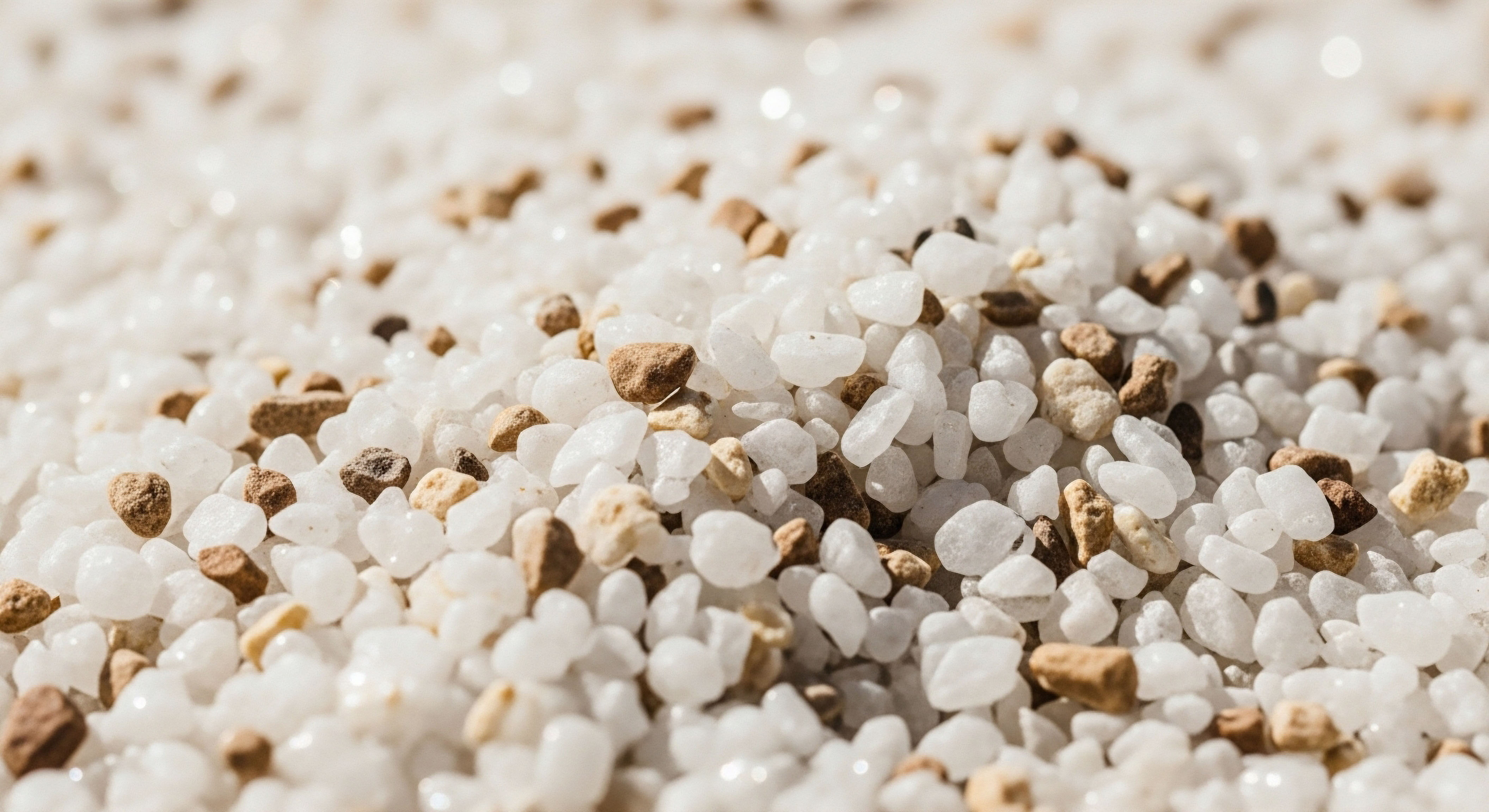

Fundamentals
Perhaps you have felt a subtle shift, a quiet diminishment of the vitality that once defined your days. The energy levels might not be what they once were, sleep could feel less restorative, or perhaps your body composition seems resistant to your efforts. These experiences are not merely subjective sensations; they often represent signals from your intricate biological systems, indicating a need for precise recalibration. Understanding these internal communications, particularly those involving hormonal messengers and their peptide precursors, forms the bedrock of reclaiming optimal function.
Many individuals seeking to restore peak physiological performance or address age-related changes consider therapeutic peptides. These small chains of amino acids Meaning ∞ Amino acids are fundamental organic compounds, essential building blocks for all proteins, critical macromolecules for cellular function. act as signaling molecules within the body, influencing a vast array of biological processes. They are designed to mimic or modulate natural bodily functions, offering a targeted approach to wellness.
When these compounds are prepared for administration, they typically arrive in a lyophilized, or freeze-dried, state. This dry powder form maintains their stability for extended periods.
The moment these peptides are mixed with a sterile liquid, a process known as reconstitution, they transition from a dormant state to an active solution. This step is critical, as it activates the peptide for its intended biological role. However, this transition also introduces a vulnerability.
The stability that characterized the lyophilized powder diminishes significantly once the peptide is in solution. The environment surrounding this newly reconstituted peptide solution plays a decisive role in preserving its integrity and, consequently, its therapeutic effectiveness.
Reconstituted peptides become active signaling molecules, but their potency is highly susceptible to environmental influences.
The body’s own endocrine system html Meaning ∞ The endocrine system is a network of specialized glands that produce and secrete hormones directly into the bloodstream. operates through a complex network of such signaling molecules. Hormones, which are often peptides or derived from them, circulate throughout the bloodstream, carrying instructions to various tissues and organs. For instance, growth hormone-releasing peptides (GHRPs) like Sermorelin or Ipamorelin stimulate the pituitary gland to release growth hormone.
If these external peptide preparations lose their structural integrity due to environmental factors, their ability to bind to specific receptors and elicit the desired physiological response is compromised. This directly impacts the potential for improved metabolic function, enhanced tissue repair, or optimized body composition.

Understanding Peptide Structure and Stability
Peptides are essentially miniature proteins, composed of amino acids linked by peptide bonds. Their specific sequence and three-dimensional folding determine their biological activity. Any alteration to this delicate structure, whether through chemical degradation or physical denaturation, can render the peptide inactive or, in some cases, even harmful.
The lyophilization process removes water, which is a primary medium for many degradation reactions, thereby stabilizing the peptide. Once water is reintroduced during reconstitution, these reactions become possible.
The stability of a peptide in solution is a function of its inherent chemical properties and the external conditions it encounters. Some peptides are inherently more robust than others, possessing amino acid sequences that are less prone to degradation. However, even the most stable peptides require careful handling post-reconstitution to maintain their therapeutic value. The goal is to ensure that the peptide molecule retains its precise shape and chemical composition, allowing it to interact correctly with its biological targets within the body.

The Initial Vulnerability of Reconstitution
The act of reconstitution itself introduces the first set of environmental considerations. The type of diluent used, its pH, and the manner in which it is mixed with the peptide powder can all influence the initial stability of the solution. Sterile bacteriostatic water, often containing benzyl alcohol, is commonly employed due to its ability to inhibit bacterial growth and maintain a suitable pH range.
Vigorous shaking or agitation during mixing can introduce air bubbles, leading to oxidation, or cause physical stress that denatures the peptide structure. A gentle, rotational mixing technique is generally advised to minimize these risks.


Intermediate
Once a peptide is reconstituted, its journey from preparation to administration is fraught with potential challenges that can diminish its potency. The environment surrounding the solution, from storage conditions to handling practices, directly influences the peptide’s molecular integrity. Understanding these influences is paramount for anyone seeking to optimize their hormonal health through peptide therapy, ensuring that the intended biochemical recalibration html Meaning ∞ Biochemical recalibration refers to the adaptive processes by which the body’s internal chemical environment is adjusted to restore or maintain optimal physiological function. is achieved.

Temperature Fluctuations and Peptide Degradation
Temperature is perhaps the most significant environmental factor affecting reconstituted peptide potency. Peptides, like many biological molecules, are sensitive to heat. Elevated temperatures accelerate chemical reactions, including those that lead to peptide degradation. This can involve processes such as hydrolysis, where water molecules break peptide bonds, or deamidation, where amino acid side chains are altered.
Refrigeration, typically between 2°C and 8°C (36°F and 46°F), is the standard recommendation for storing reconstituted peptides. This temperature range significantly slows down degradation kinetics, preserving the peptide’s structure for a longer duration. Freezing, while extending shelf life further for some peptides, can introduce its own set of challenges, such as protein aggregation Meaning ∞ Protein aggregation refers to the pathological process where proteins misfold and then self-associate, forming insoluble clusters or deposits within cells or extracellular spaces. upon thawing, which can reduce bioavailability. Repeated freeze-thaw cycles are particularly detrimental, causing physical stress and structural damage to the delicate peptide molecules.
Maintaining consistent refrigeration is essential for preserving the structural integrity and biological activity of reconstituted peptides.
Consider the implications for individuals undergoing Testosterone Replacement Therapy (TRT) or utilizing growth hormone Meaning ∞ Growth hormone, or somatotropin, is a peptide hormone synthesized by the anterior pituitary gland, essential for stimulating cellular reproduction, regeneration, and somatic growth. peptides. While testosterone itself is a steroid and less susceptible to these specific degradation pathways, the principles of proper storage apply broadly to all therapeutic compounds. For peptides like Sermorelin or Ipamorelin, which are administered subcutaneously, ensuring the vial remains within the recommended temperature range from the moment of reconstitution until the final dose is critical for consistent therapeutic outcomes.

Light Exposure and Oxidative Stress
Light, particularly ultraviolet (UV) light, represents another environmental stressor for reconstituted peptides. UV radiation possesses sufficient energy to induce chemical changes within peptide molecules, often leading to oxidation. Oxidation involves the loss of electrons from atoms within the peptide, which can alter amino acid residues, break peptide bonds, and ultimately change the peptide’s three-dimensional conformation. This structural alteration directly impairs the peptide’s ability to bind to its target receptors, rendering it biologically inactive.
Many peptide vials are made of amber glass, which helps to filter out harmful UV wavelengths. Storing reconstituted peptides Meaning ∞ Reconstituted peptides are lyophilized compounds restored to a liquid, injectable form by adding a specific diluent, typically bacteriostatic water. in their original amber vials, away from direct sunlight or strong artificial light sources, is a simple yet effective protective measure. Even brief exposures to intense light can initiate degradation pathways that continue even after the light source is removed. This cumulative damage can significantly reduce the overall potency of the solution over its intended use period.

The Role of Ph and Contamination
The pH of the reconstituted solution is a critical determinant of peptide stability. Each peptide has an optimal pH range where its molecular structure is most stable and its biological activity is maximized. Deviations from this optimal range, whether too acidic or too alkaline, can lead to denaturation, aggregation, or chemical degradation.
The diluent used for reconstitution, such as bacteriostatic water, is formulated to provide a pH that supports peptide stability. Introducing other substances or using non-sterile water can alter the pH, compromising the peptide.
Contamination, whether microbial or particulate, poses a direct threat to peptide potency and patient safety. Bacteria or fungi introduced during reconstitution or subsequent handling can metabolize the peptide, breaking it down into inactive components. Particulate matter can physically interfere with the peptide’s structure or lead to adverse reactions upon injection.
Strict aseptic technique during reconstitution Precise injection technique minimizes tissue trauma and optimizes medication dispersion, significantly reducing post-injection discomfort and enhancing therapeutic outcomes. and handling is therefore non-negotiable. This includes using sterile needles, syringes, and diluents, and performing the process in a clean environment.
The table below summarizes key environmental factors html Meaning ∞ Environmental factors are external non-genetic influences on an organism’s development, health, and function. and their impact on peptide stability ∞
| Environmental Factor | Impact on Peptide Potency | Protective Measures |
|---|---|---|
| Temperature | Accelerates chemical degradation (hydrolysis, deamidation); can cause aggregation if frozen/thawed repeatedly. | Refrigerate (2-8°C); avoid freezing/thawing cycles. |
| Light Exposure | Induces oxidation, altering peptide structure and activity. | Store in amber vials; keep away from direct sunlight and strong artificial light. |
| pH Imbalance | Causes denaturation, aggregation, or chemical breakdown outside optimal range. | Use appropriate, sterile diluent (e.g. bacteriostatic water); avoid mixing with other solutions. |
| Microbial Contamination | Bacteria/fungi metabolize and degrade peptides. | Employ strict aseptic technique during reconstitution and handling. |
| Physical Agitation | Causes denaturation and aggregation due to mechanical stress. | Mix gently by rotation, avoid vigorous shaking. |
Understanding these factors allows for proactive measures to safeguard the therapeutic efficacy of reconstituted peptides. This attention to detail is a cornerstone of personalized wellness protocols, ensuring that the body receives the precise biochemical signals intended for its recalibration.
Academic
The journey of a peptide from its synthesized form to its biological target within the human system is a complex one, fraught with molecular vulnerabilities. While the initial focus often rests on the peptide’s intended pharmacological action, a deeper scientific understanding reveals that its very integrity is continuously challenged by environmental forces. This section explores the intricate molecular mechanisms by which external factors compromise reconstituted peptide potency, linking these degradative pathways to the broader context of endocrine system function and metabolic health.

Molecular Mechanisms of Peptide Degradation
Peptide degradation Meaning ∞ Peptide degradation is the precise biochemical process where enzymes break down peptides into smaller fragments or individual amino acids. in solution is not a singular event but a constellation of specific chemical reactions, each influenced by distinct environmental parameters. These reactions collectively diminish the peptide’s ability to interact with its specific receptors, thereby reducing its biological efficacy.
- Oxidation ∞ This process primarily affects amino acid residues such as methionine, tryptophan, histidine, and cysteine. Exposure to oxygen, light, or trace metal ions can catalyze the formation of reactive oxygen species, which then attack these susceptible residues. For instance, methionine oxidation to methionine sulfoxide can significantly alter the peptide’s conformation, hindering receptor binding. This is particularly relevant for peptides containing these sensitive amino acids, impacting their half-life and activity.
- Deamidation ∞ Asparagine and glutamine residues are prone to deamidation, especially at neutral or slightly alkaline pH values. This reaction involves the removal of an amide group, leading to the formation of aspartic acid or glutamic acid, respectively. This seemingly minor change introduces a negative charge and can alter the peptide’s secondary and tertiary structure, affecting its biological recognition.
- Hydrolysis ∞ The peptide bond itself, which links amino acids, can be cleaved by hydrolysis, particularly under extreme pH conditions (very acidic or very alkaline) or elevated temperatures. This results in the fragmentation of the peptide into smaller, often inactive, components. The rate of hydrolysis is significantly accelerated in the presence of water, underscoring the importance of proper reconstitution and storage.
- Aggregation ∞ Peptides, especially at higher concentrations or under stress conditions (temperature extremes, pH shifts, agitation), can self-associate to form insoluble aggregates. This process reduces the concentration of active monomeric peptide available for therapeutic action. Aggregation can also elicit an immune response in the recipient, leading to potential adverse effects.
The interplay of these degradative pathways is not always linear. For example, an initial oxidative event might expose new sites for hydrolysis, creating a cascade of degradation. The stability profile of each specific peptide is unique, dictated by its amino acid sequence, its three-dimensional structure, and the formulation excipients.

How Environmental Stressors Impact Endocrine Modulators?
Consider the clinical application of Growth Hormone Peptide Therapy, involving compounds like Sermorelin, Ipamorelin, or CJC-1295. These peptides are designed to stimulate the pulsatile release of endogenous growth hormone from the pituitary gland. Their efficacy hinges on their ability to reach the pituitary intact and bind effectively to the growth hormone-releasing hormone receptor (GHRHR). If environmental factors compromise their potency prior to administration, the downstream physiological effects—such as improved body composition, enhanced tissue repair, or better sleep quality—will be attenuated.
For instance, a Sermorelin solution stored improperly at room temperature for an extended period will undergo accelerated hydrolysis Meaning ∞ Hydrolysis represents a fundamental chemical reaction where a compound reacts with water, cleaving chemical bonds and forming new compounds. and oxidation. The resulting fragmented or oxidized molecules will have a reduced affinity for the GHRHR, leading to a blunted growth hormone response. This directly impacts the patient’s progress, despite adherence to the prescribed dosage. The individual may experience persistent symptoms of growth hormone deficiency, such as fatigue or difficulty with recovery, simply because the therapeutic agent was compromised before it even entered the body.

The Systemic Repercussions of Compromised Peptide Potency
The impact of environmental factors on reconstituted peptide potency extends beyond the immediate loss of therapeutic effect. When a compromised peptide is administered, it introduces an element of unpredictability into a carefully designed personalized wellness protocol. This unpredictability can lead to several challenges ∞
- Suboptimal Clinical Outcomes ∞ The primary concern is the failure to achieve the desired physiological response. If a peptide intended to support metabolic function is degraded, the patient’s metabolic markers may not improve as expected, leading to frustration and a perceived lack of efficacy of the protocol itself.
- Dosing Inaccuracy ∞ A degraded peptide means that the actual dose of active compound received by the body is lower than the intended dose. This effectively makes the prescribed dosage an arbitrary number, undermining the precision of biochemical recalibration.
- Potential for Immunogenicity ∞ Aggregated or chemically modified peptides can be recognized as foreign by the immune system, potentially leading to the formation of anti-drug antibodies. These antibodies can neutralize the therapeutic peptide, further reducing its efficacy, or even trigger adverse immune reactions.
- Misinterpretation of Patient Response ∞ When a patient does not respond as anticipated to a peptide therapy, clinicians might initially consider adjusting the dosage or exploring alternative treatments. However, if the root cause is environmental degradation of the peptide, these adjustments will not address the underlying issue, leading to prolonged suboptimal health.
This deep understanding of environmental influences on peptide stability Meaning ∞ Peptide stability refers to a peptide’s inherent capacity to maintain its original chemical structure, three-dimensional conformation, and biological activity over a specified period and under defined environmental conditions, such as temperature, pH, or exposure to enzymes. underscores the importance of meticulous handling and storage practices. It highlights that the efficacy of advanced therapeutic protocols, such as those involving growth hormone peptides html Meaning ∞ Growth Hormone Peptides are synthetic or naturally occurring amino acid sequences that stimulate the endogenous production and secretion of growth hormone (GH) from the anterior pituitary gland. or targeted hormonal optimization, relies not only on the inherent pharmacological properties of the compounds but also on the rigorous preservation of their molecular integrity from the moment of reconstitution until administration.

How Does Diluent Choice Influence Peptide Longevity?
The selection of the diluent for peptide reconstitution Meaning ∞ Peptide reconstitution involves dissolving lyophilized peptide powder into a sterile liquid solvent, typically bacteriostatic water. is a critical scientific consideration, extending beyond mere sterility. The diluent’s composition directly influences the solution’s pH, tonicity, and potential for chemical interaction with the peptide. Bacteriostatic water for injection (BWFI), containing 0.9% benzyl alcohol, is widely favored.
Benzyl alcohol acts as a preservative, inhibiting microbial growth, which is a significant factor in maintaining sterility over multiple withdrawals from a single vial. Its presence also helps to maintain a slightly acidic pH, typically around 5.0-6.0, which is often optimal for the stability of many therapeutic peptides, minimizing hydrolysis and deamidation Meaning ∞ Deamidation refers to a non-enzymatic chemical reaction involving the removal of an amide group from specific amino acid residues, primarily asparagine and glutamine, within proteins or peptides. rates.
In contrast, plain sterile water for injection lacks a preservative, making the reconstituted solution susceptible to microbial contamination after the first puncture. While suitable for immediate, single-use administration, it is not ideal for multi-dose vials. Saline solutions (0.9% sodium chloride) are isotonic, which can be more comfortable for subcutaneous injection, but their pH can vary and may not always be optimal for peptide stability, potentially accelerating degradation for certain compounds. The choice of diluent, therefore, is a deliberate scientific decision, balancing sterility, stability, and patient comfort to ensure the peptide retains its full therapeutic potential.
References
- Wang, Y. J. & Singh, J. (2013). Biological Drug Products ∞ Development and Strategies. John Wiley & Sons.
- Cleland, J. L. & Langer, R. (1994). Formulation and Delivery of Proteins and Peptides. American Chemical Society.
- Arakawa, T. Philo, J. S. & Tsumoto, K. (2013). Protein Aggregation ∞ Pathways and Prevention in Biopharmaceuticals. John Wiley & Sons.
- Manning, M. C. Patel, K. & Borchardt, R. T. (1989). Stability of protein pharmaceuticals ∞ an update. Pharmaceutical Research, 6(11), 903-918.
- Jiskoot, W. & Crommelin, D. J. A. (2005). Pharmaceutical Biotechnology ∞ Fundamentals and Applications. Taylor & Francis.
- Volkin, D. B. & Middaugh, C. R. (1992). The effect of temperature on protein stability. Current Opinion in Biotechnology, 3(4), 364-370.
- Liu, J. & Langer, R. (2004). The effect of light on protein stability. Journal of Pharmaceutical Sciences, 93(11), 2775-2788.
- Roberts, C. J. (2014). Protein aggregation and its effect on product quality. Current Opinion in Colloid & Interface Science, 19(5), 375-381.
- Kishore, R. S. & Pikal, M. J. (2007). The influence of pH on protein stability. Journal of Pharmaceutical Sciences, 96(10), 2697-2708.
Reflection
The journey toward understanding your own biological systems is a profound one, often beginning with a simple question about a symptom or a desire for greater vitality. We have explored how the very environment surrounding a reconstituted peptide can dictate its effectiveness, influencing everything from cellular signaling to your overall sense of well-being. This knowledge is not merely academic; it is a call to precise, informed action.
Consider this information a foundational step in your personal health recalibration. The principles of protecting peptide potency extend beyond the laboratory; they speak to the meticulous care required in every aspect of a personalized wellness protocol. Your body is a complex, responsive system, and providing it with compounds of uncompromised integrity is a cornerstone of supporting its innate capacity for balance and function.
What insights does this deeper understanding spark within your own health narrative? How might a renewed attention to the details of therapeutic preparation align with your aspirations for sustained vitality? The path to reclaiming optimal function is a collaborative effort, blending scientific precision with a deep respect for your unique physiological landscape.










